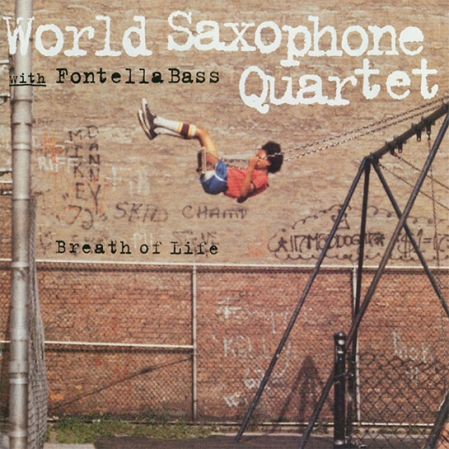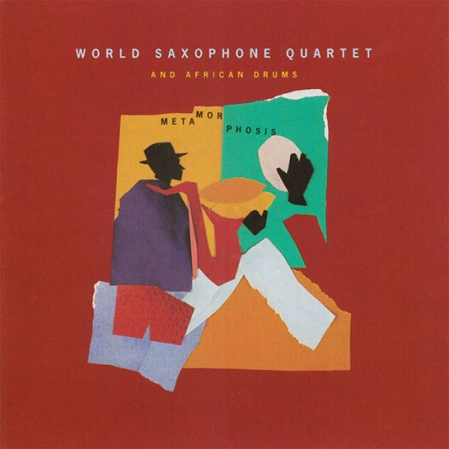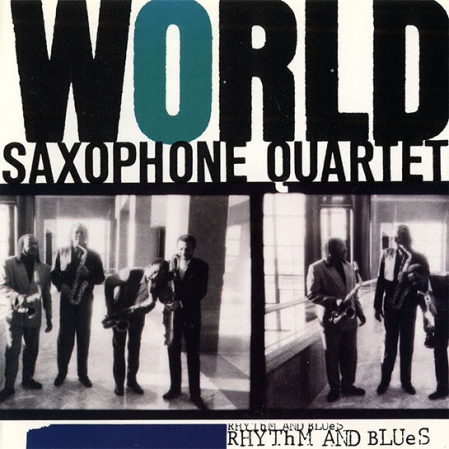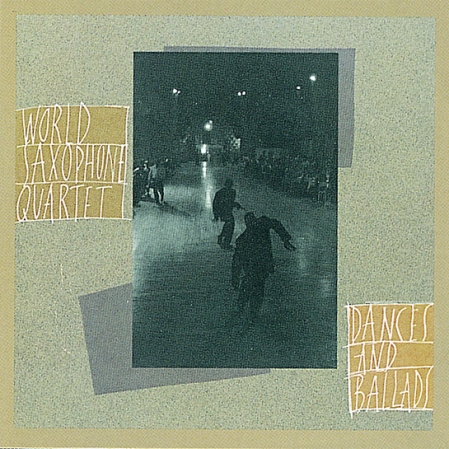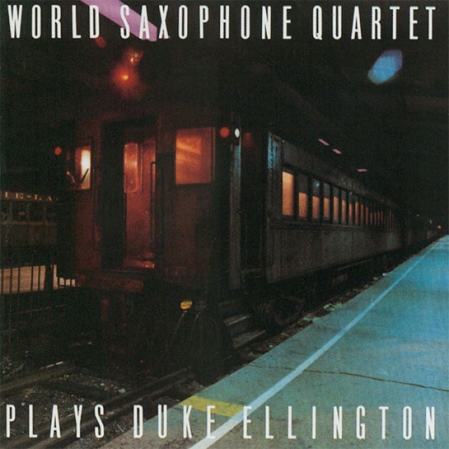The World Saxophone Quartet began performing as a unit in 1976, and was the brainchild of Ed Jordan, head of the music department at New Orleans Southern University. He had heard the saxophonists in their individual groups, and hired them to do a show together. “We liked it, and started doing gigs at other colleges,” remembers David Murray. Although three of the original members -- Julius Hemphill, Oliver Lake and Hamiet Bluiett -- knew each other from St. Louis, it was not until this event that they decided to create a group consisting only of four saxophones. Since then, the group has recorded eight albums together, including the critically-heralded “World Saxophone Quartet Plays Duke Ellington” -- voted a Top Pop Album of 1986 by The New York Times. Describing the group as “probably the most protean and exciting new jazz bands of the ‘80’s” the Times has called the WSQ “The most original and important group to emerge since Miles Davis, Ornette Coleman and John Coltrane redefined group improvisation in the late ‘50’s.”
The WSQ places consistently in the top five groups in Downbeat magazine’s annual Critic’s Poll, and in 1987 was voted “Best Jazz Group” in the Playboy Readers Poll. The WSQ has an extremely diverse following, and has toured prolifically throughout the U.S., Europe and Japan, where they scored a major success as part of the “Live Under the Sky” Festival. Their reputation hinges, most importantly, upon repertoire that belongs exclusively to them. It is the group's own music that is featured on their Nonesuch album “Dances and Ballads.” The ten compositions include their signature tune “Hattie Wall,” the video for which was directed by Robert Longo with a performance by dancer/choreographer Bill T. Jones. Cited as one of that year’s top ten jazz albums by Francis Davis of the Philadelphia Inquirer, “Dances and Ballads” “equals their previous best efforts,” according to Downbeat, and “contains several new pieces that may someday be considered among the Quartet’s classics.”
OLIVER LAKE (alto sax, tenor sax, soprano sax, flute) grew up in St. Louis, and received professional encouragement from trumpeter Lester Bowie. After teaching at the American Center for Artists and Students in Paris and studying at the Electronic Workshop, he moved to New York in 1976 and is currently leading his own highly stylized funk-reggae group Jump Up, as well as a jazz quartet. He is also a published poet.
DAVID MURRAY (tenor sax, bass clarinet) began leading his own rhythm and blues group at the age of 12, and there is no question that his style is rooted in, but not confined to, a soulful blend of John Coltrane, Ben Webster, R&D and Sonny Rollins. He has recorded as a leader with a trio, a quartet, an octet and a big band.
HAMIET BLUIETT (baritone sax, alto clarinet) openly acknowledges the dramatic impact of hearing Ellington baritone saxophonist Harry Carney live in Boston early on. In addition to the aforementioned Black Artists Group, his credits include associations with the Gateway Symphony, Charles Mingus, Stevie Wonder and Marvin Gaye. He has also been chosen in the past to play with the American Jazz Orchestra, led by John Lewis.
ARTHUR BLYTHE (alto sax) joined the World Saxophone Quartet in November 1989. Born in California, Blythe began playing the alto sax at age nine and was performing in a blues band by the time he was thirteen. He openly acknowledges the impact John Coltrane has had on his playing. He joined Horace Tapscott’s band in 196k, an association that ended ten years later when he moved to New York. In 1975 he joined Chico Hamilton’s band, where he remained for two years. Since 1977 Blythe has led his own ensembles and recorded many solo albums.
The World Saxophone Quartet began performing as a unit in 1976, and was the brainchild of Ed Jordan, head of the music department at New Orleans Southern University. He had heard the saxophonists in their individual groups, and hired them to do a show together. “We liked it, and started doing gigs at other colleges,” remembers David Murray. Although three of the original members -- Julius Hemphill, Oliver Lake and Hamiet Bluiett -- knew each other from St. Louis, it was not until this event that they decided to create a group consisting only of four saxophones. Since then, the group has recorded eight albums together, including the critically-heralded “World Saxophone Quartet Plays Duke Ellington” -- voted a Top Pop Album of 1986 by The New York Times. Describing the group as “probably the most protean and exciting new jazz bands of the ‘80’s” the Times has called the WSQ “The most original and important group to emerge since Miles Davis, Ornette Coleman and John Coltrane redefined group improvisation in the late ‘50’s.”
The WSQ places consistently in the top five groups in Downbeat magazine’s annual Critic’s Poll, and in 1987 was voted “Best Jazz Group” in the Playboy Readers Poll. The WSQ has an extremely diverse following, and has toured prolifically throughout the U.S., Europe and Japan, where they scored a major success as part of the “Live Under the Sky” Festival. Their reputation hinges, most importantly, upon repertoire that belongs exclusively to them. It is the group's own music that is featured on their Nonesuch album “Dances and Ballads.” The ten compositions include their signature tune “Hattie Wall,” the video for which was directed by Robert Longo with a performance by dancer/choreographer Bill T. Jones. Cited as one of that year’s top ten jazz albums by Francis Davis of the Philadelphia Inquirer, “Dances and Ballads” “equals their previous best efforts,” according to Downbeat, and “contains several new pieces that may someday be considered among the Quartet’s classics.”
OLIVER LAKE (alto sax, tenor sax, soprano sax, flute) grew up in St. Louis, and received professional encouragement from trumpeter Lester Bowie. After teaching at the American Center for Artists and Students in Paris and studying at the Electronic Workshop, he moved to New York in 1976 and is currently leading his own highly stylized funk-reggae group Jump Up, as well as a jazz quartet. He is also a published poet.
DAVID MURRAY (tenor sax, bass clarinet) began leading his own rhythm and blues group at the age of 12, and there is no question that his style is rooted in, but not confined to, a soulful blend of John Coltrane, Ben Webster, R&D and Sonny Rollins. He has recorded as a leader with a trio, a quartet, an octet and a big band.
HAMIET BLUIETT (baritone sax, alto clarinet) openly acknowledges the dramatic impact of hearing Ellington baritone saxophonist Harry Carney live in Boston early on. In addition to the aforementioned Black Artists Group, his credits include associations with the Gateway Symphony, Charles Mingus, Stevie Wonder and Marvin Gaye. He has also been chosen in the past to play with the American Jazz Orchestra, led by John Lewis.
ARTHUR BLYTHE (alto sax) joined the World Saxophone Quartet in November 1989. Born in California, Blythe began playing the alto sax at age nine and was performing in a blues band by the time he was thirteen. He openly acknowledges the impact John Coltrane has had on his playing. He joined Horace Tapscott’s band in 196k, an association that ended ten years later when he moved to New York. In 1975 he joined Chico Hamilton’s band, where he remained for two years. Since 1977 Blythe has led his own ensembles and recorded many solo albums.

